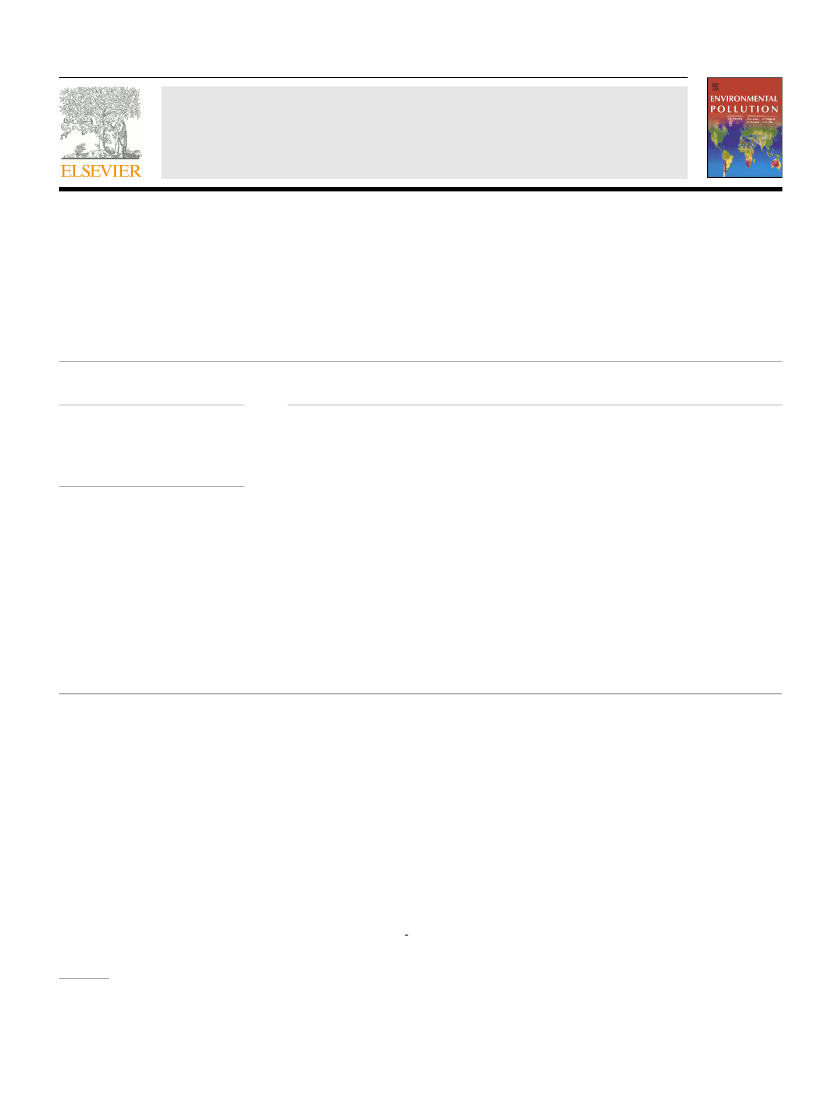
Environmental Pollution xxx (xxxx) 113985
Contents lists available at ScienceDirect
Environmental Pollution
Elevated mercury concentrations in biota despite reduced sediment concentrations in a
contaminated coastal area, Harboøre Tange, Denmark
☆
Poul Bjerregaard
∗
, Torben Grau Schmidt, Maria Pedersen Mose
Department of Biology, University of Southern Denmark, Campusvej 55, DK-5230 Odense, Denmark
ARTICLE INFO
Article history:
Received 7 October 2019
Received in revised form 8 January 2020
Accepted 13 January 2020
Available online xxx
ABSTRACT
Keywords
Mercury
Sediment
Biota
Benthic
UN
CO
RR
EC
TE
D
Metals sequestered in coastal sediments are normally considered to be stable, but this investigation shows
–
somewhat surprisingly
–
that mercury concentrations in a previously contaminated area, Harboøre Tange, Den-
mark, have decreased since the 1980s. Mercury concentrations were determined in sediment and benthic biota
and present values were compared to values in the 1980s and values from areas without known; history of mer-
cury contamination. Concentrations in both the upper 20 cm of the sediments and; biota are considerably lower
now compared to latest monitoring (1980s). Sediment.concentrations at most locations have decreased from the
100–300 ng Hg g
−1
dry weight (dw) level to levels below the Background Concentration (BC) of 50 ng Hg g
−1
dw defined by Oslo-Paris Convention for the Protection of the Marine Environment of the North-East Atlantic;
some stations are at the 2–10 ng Hg g
−1
dw level characteristic of Danish coastal sediments with no known
history of mercury contamination. Concentrations of mercury in the benthic biota along Harboøre Tange have
also decreased since the 1980s but despite the lowered mercury concentrations in the sediments, concentrations
in most samples of benthic invertebrate fauna still exceed those in uncontaminated coastal areas and also the
Environmental Quality Standard (EQS) of 20 ng Hg g
−1
wet weight (≈100 ng Hg g
−1
dry weight) defined by
the European Union's Water Framework Directive. Concentration ranges in selected organisms are: (Harboøre
Tange l980s/Harboøre Tange now/uncontaminated areas - given in ng Hg g
−1
dw): Periwinkles
Littorina littorea
9000/150–450/55-77, blue mussels
Mytilus edulis
up to 9000/300–500/40–170, cockles
Cerastoderma edule
up
to 8000/400–1200/200, brown shrimp
Crangon crangon
700–2200/150-450/47, eelgrass
Zostera marina
up to
330/25–70/12. The present results - together with a literature review - show that a simple and straight forward
relationship between the concentrations of mercury in sediment and benthic organisms does not necessarily exist.
© 2020
1. Introduction
Coastal and estuarine sediments have long been recognized as sinks
for pollutants, and once buried in the sediments, metals and non-degrad-
able, organic contaminants may persist for years or decades (e.g.
Baeyens et al., 2005; Ridgway and Shimmield, 2002). Due to its ca-
pacity to be methylated and accumulate to harmful concentrations along
aquatic food chains (Grandjean et al., 1997; Scheuhammer et al.,
2008), releases of mercury to the environment from point sources and
on a more global scale have been a major concern for decades (UNEP,
2013).
The western part of Limfjorden, Denmark, Nissum Broad along
Harboøre Tange (Fig. 1) was heavily contaminated with mercury dur-
ing the 1950s and 1960s - mainly due to discharges from the pesti-
cide-producing factory, Cheminova (Lyngby and Brix, 1987). It is esti
∗
☆
This paper has been recommended for acceptance by Prof. Wen-Xiong Wang.
Corresponding author.
E-mail address:
[email protected] (P. Bjerregaard)
mated that approximately 30 tonnes of mercury were discharged into
the Nissum Broad with process waste water, lost by production mistakes
and deposited in the vicinity of the factory (Kiorboe et al., 1983).
Thresholds and quality criteria for mercury in sediment and biota
have been defined by various organizations. The Background Concen-
tration (BC) and Background Assessment Concentration (BAC) for mer-
cury in sediment are 50 and 70 ng Hg g
−1
dw, respectively, defined
by the Oslo-Paris Convention for the Protection of the Marine Envi-
ronment of the North-East Atlantic (OSPAR, 2009). The threshold be-
low which there is a low risk of adverse effects towards the biota (Ef-
fects Range Low
–
ERL) is 150 ng Hg g
−1
dw sediment (Long et al.,
1998; Long et al., 1995; OSPAR, 2009). The Environmental Qual-
ity Standard (EQS) of 20 ng Hg g
−1
wet weight (corresponding to ap-
proximately 100 ng Hg g
−1
dw) in invertebrates and fish defined in the
European Union Water Framework Directive (EC, 2008; EU, 2008) is
supposed to protect the marine food chains from biomagnifying mer-
cury to harmful concentrations in top predators; the potential toxic-
ity associated with elevated levels of mercury in aquatic food chains
is well documented (reviewed by Driscoll et al., 2013). Until 2013
https://doi.org/10.1016/j.envpol.2020.113985
0269-7491/© 2020.
PR
OO
F
journal homepage: http://ees.elsevier.com